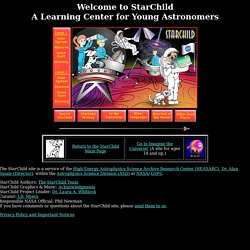

Astronomy News - Space Science - Articles and Images. The Earth and Beyond. Welcome to The Earth and Beyond Hello, my name is Tim O'Brien.

I'm an astronomer working at The University of Manchester's Jodrell Bank Observatory. As an astronomer my job is to try and understand how the universe works and my main interest is why some stars explode - more about this later! I also get to visit lots of schools and share amazing facts with children and teachers about the Sun, Earth and Moon, the stars and planets, and the Universe as we know it! Now, in the Children’s University, I can share the excitement with you. Exploding stars You may know the names of some patterns of stars (called constellations) such as Orion or the Great Bear. This picture shows Orion the Hunter and Taurus the Bull with the position of an exploded star known as the Crab Nebula. We're all made of stars Understanding why stars explode is very important because most of the chemical elements (carbon, oxygen, nitrogen and so on) were made inside stars and are spread out into space when they explode.
Astronomy Citizen Science Projects – Our Wide Sky. Star Walk 2 Night Sky Map: Watch Stars and Planets on the App Store. Curious Kids: Where do black holes lead to? This is an article from Curious Kids, a series for children.

The Conversation is asking kids to send in questions they’d like an expert to answer. All questions are welcome – serious, weird or wacky! You might also like the podcast Imagine This, a co-production between ABC KIDS listen and The Conversation, based on Curious Kids. Hi. My name is Merion and my question to Curious Kids is: where do black holes lead to? Hi Merion. Black holes can form when a massive star dies. These stars are also made up of very hot gas which lets off a lot of heat. Normally the pull from gravity and the push from the heat balance each other out. Read more: Curious Kids: Does space go on forever? You will never be able to escape a black hole Because black holes are made up of a lot of mass squished into a very small area of space (in science speak we say black holes are very dense) they create a lot of gravity. Sadly, it is really hard to get a camera good enough to take pictures like that. Teachers using the Hub – Space and astronomy — Science Learning Hub.
Te iwa o Matariki. This Is an Amazing Pilot’s-Eye View of the Milky Way.
Black Hole Comparison. The Edge of the Sky: All You Need to Know About the All-There-Is by Roberto Trotta. Fun Science: Stars. StarChild: A Learning Center for Young Astronomers. The StarChild site is a service of the High Energy Astrophysics Science Archive Research Center (HEASARC), Dr.

Alan Smale (Director), within the Astrophysics Science Division (ASD) at NASA/GSFC. StarChild Authors: The StarChild Team StarChild Graphics & Music: Acknowledgments StarChild Project Leader: Dr. Laura A. Whitlock Curator: Responsible NASA Official: If you have comments or questions about the StarChild site, please send them to us. Life Cycle of a Star. Star Dust. Stardust Lawrence Krauss Tags: science Posted in Facts Comments Hey Posted by Jon on 7/8/2010 6:19:26 PM I prefer the way Carl Sagan said it: The Universe is all that is, or ever was, or ever will be.

Posted by Gary on 7/12/2010 1:23:41 AM if we are made of stardust,how are the world-wars are thrust upon us ? Posted by sastri on 8/17/2010 6:56:03 AM @sastri No. Posted by Geoff on 10/14/2010 2:09:57 PM I don't have much use for wars but they're part of the picture as point counter point yin-yang and the billion other contraries assembling in our plane.
Posted by jim on 11/16/2010 3:02:31 AM Eh, whats for dinner? Outer Space: "I'm A Star," The Stars Song by StoryBots. Albert & Junior - Why Do Stars Twinkle? Van Gogh's Starry Night painted on dark water by Garip Ay.